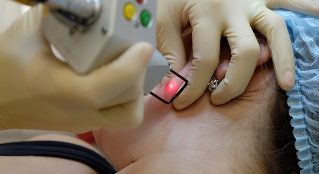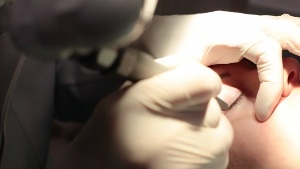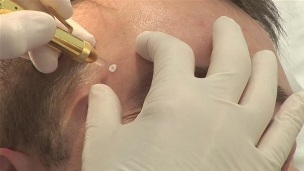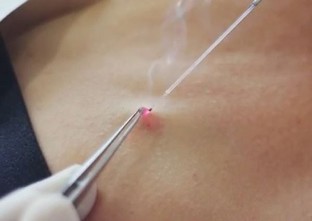
Laser removal of tumors is a very common and effective procedure that helps get rid of unwanted growths. This is a relatively new method that appeared in the medical arsenal not so long ago, but has already managed to prove its advantage over other methods of removal. The precursors of laser destruction were removal using liquid nitrogen, electricity or a scalpel. All this can cause significant discomfort to the patient, while laser removal shows high results with painless intervention.
Why remove
Papillomas, which are growths of various shapes and sizes, are usually benign neoplasms. They are localized on the mucous membranes of the wearer or his skin. The main reason for their appearance is the action of the human papilloma virus, in most cases sexually transmitted.
Removing these accumulations performs several tasks at once:
- Aesthetic correction.A patient with growths may feel uncomfortable with excessive attention to them from others. Therefore, a person may feel insecure and uncomfortable, even if growth does not pose a danger to him.
- Prevent injuries.If the growth is in a traumatic place where the patient constantly touches it, this can lead to the separation of the protrusion. In addition, when you try to cover the papilloma with clothing, such a problem can occur as rubbing the affected area. This is fraught with papilloma injury and possible subsequent infection. Damage can lead to the penetration of microbes, which can cause inflammation in the wound. If this happens, the damaged area should be treated with peroxide and go to the clinic immediately to remove the rest of the papilloma.
- Reduce the risk of cancer.Despite the fact that the growths are benign, there is such a variety of their manifestations as warts. They are usually located in intimate places and pose a great danger to the development of cancer. To prevent the disease, all warts must be removed.
Do not remove growths yourself. All attempts to tie the papilloma with a thread, comb, applying some chemical agent on it can lead to its deterioration.
Advantages of the procedure
Laser destruction has several advantages over other removal methods.These include:
- Guaranteed result.Thanks to the action of the laser, the excitation is completely eliminated, leaving nothing even in the deep subcutaneous layers. The device is able to penetrate deep enough to clear all traces of the presence of a tumor.
- Painlessness.Laser exposure gives the patient minimal pain. If you add pre-anesthesia with local anesthetics to the procedure, there is no pain at all.
- Procedure speed. Laser papilloma removal requires 2 to 5 minutes per item.
- Non-invasive.The laser beam is in a strictly limited area and does not exceed it. In this case, more than one part of the laser does not touch the site of the procedure. This is very important as this method helps to minimize the risk of infection and gives a high guarantee of sterility.
- No postoperative scars.If the work is done correctly, there should be no traces of laser action at the site of exposure. This is due to the fact that the affected tissue evaporates completely and then takes its place in a new, intact skin.
- A bloodless way to delete.The laser beam heats the capillaries that supply blood, quickly sealing their walls. As a result, the bleeding stops and does not resume after the operation.
- Suitable for different parts of the body.Not all removal methods can be used in every part of the body. Intimate areas, eyelids, etc. are considered particularly sensitive. Laser destruction does a good job of dealing with growths in such areas due to the precision of the laser beam.
All of these factors make laser removal one of the most sought-after procedures for removing growths.
Contraindications
The list of contraindications for this procedure is not as long as for other methods of destruction.Among the bans on laser removal:
- diabetes mellitus;
- oncology;
- exacerbation of chronic diseases;
- epilepsy;
- diseases related to problems with the endocrine system;
- poor blood clotting;
- HIV or AIDS;
- acute inflammatory diseases.
In addition, patients who have recently had influenza or acute respiratory infections should also postpone the procedure for some time.
Description of the procedure
Before starting any procedure to remove growths, the doctor will disinfect the area to be operated on. In some cases, local anesthetic is used. An ointment or spray is usually used for this. After administration of the anesthetic drug, 2-3 minutes pass and the removal process begins.

The laser beam is aimed at the affected area and appears to cauterize unwanted growth. At this point, the contents of the cells evaporate under the influence of the laser, removing any layer of affected tissue. This happens not only in easily accessible places in open spaces. The procedure for removing a papilloma, for example on the eyelid, is the same. The only nuance in this area is that a special cooling method is used for the patient to prevent pain and burns at this sensitive point.
Neoplasms in intimate areas are removed in the same way. But here the doctor usually uses an anesthetic injection as an anesthetic, injecting the growth from different sides.
The very moment of inserting the needle can be somewhat painful, but after a few minutes the sensitivity in the area of influence completely disappears and further manipulations are completely painless.
The affected area becomes a small bloodless wound. During destruction, it is disinfected due to the operation of the laser. After removing the buildup, the doctor treats the affected area with potassium permanganate.
After the procedure, the patient may have slight redness, itching, or slight soreness at the site of papilloma removal.
This reaction is considered normal because, despite the non-invasiveness of the procedure, there was an interference with the integrity of the skin during the operation.All discomfort should disappear completely 2-4 days after the procedure.
Later, a dry crust appears over the wound. There is a layer of already healthy skin under it, so that its protective shell cannot be torn off until it falls off on its own. Otherwise, a scar may remain on the skin, and the recovery process itself may take longer.
Consequences
Complications after laser destruction are rare. As a rule, their presence is associated with diseases that the patient already has, which he did not cure before the procedure. For example, if the patient has had skin inflammation, this may contribute to the appearance of pigmentation. If the skin itself is very sensitive, there may be a slight redness associated with burning. In case of a high allergic reaction, swelling at the site of exposure may occur.
To rule out any side effects, it is necessary to consult a doctor before performing laser destruction.
Caution after procedure
After removing the buildup, the patient must adhere to the following rules:
- do not allow water to enter the wound for 2-3 days;
- refrain from visiting saunas, baths and swimming pools;
- do not rub the damaged area with a towel;
- do not use adhesive plaster on the wound;
- do not treat the papilloma removal site with exfoliants, lotions containing alcohol;
- Avoid exposure to ultraviolet rays.
It is necessary to perform antiseptic treatment of the wound several times a day. This should be done until the scab separates. This treatment should prevent infection and help speed up the time to complete healing.You can take iodine or potassium permanganate solution to treat the affected area.
After the removal site can be treated with anti-inflammatory ointments.
Their action is aimed at accelerating tissue regeneration, relieving inflammation and swelling. Before choosing a particular drug, it is best to consult a doctor.
Which method is better
Laser removal is not the only method to deal with unwanted growth. There are other ways, among which stand out:

Cryodestruction.
Based on the removal of papillomas with liquid nitrogen. Due to exposure to low temperatures, the accumulation begins to collapse and eventually disappears completely. The method is effective, but has several drawbacks. Among them is the impossibility of complete control over the depth of action of nitrogen. The substance can penetrate very deeply, touching a healthy area or, conversely, affect only superficially, without affecting all layers of the localization of the accumulation.
In addition, this method is characterized by:
- the possibility of postoperative scars;
- painful sensations;
- inability to guarantee the result after the first procedure.
In this way, laser destruction shows greater efficiency than cryodestruction. Laser removal is less painful and is more likely to guarantee the desired result.
Remove radio waves.
This method of destruction is performed using a special device that acts on the papilloma through radio waves. This encourages cutting of the accumulation due to the point effect of the radio knife. The precision of the procedure is very high so that the adjacent tissues are not affected. However, the risk of burns or infection is extremely low.
This method is suitable for removing small benign lesions. It is highly efficient, which makes it as popular as laser destruction. Both methods are considered modern approaches to removing papillomas and are used equally well in medicine.

Electrocoagulation.
This method is based on the action of a high-frequency electric current acting on the papilloma directly at the site of the lesion. Electrocoagulation is now considered a common but outdated method. This method allows you to prevent bleeding after removal of the papilloma by burning the vessels.
However, when using high frequency current, patients experience pain that occurs even after anesthesia. This leads some patients to abandon electrocautery, choosing laser removal as a more advanced and painless method.
Estimated price
The price range depends not only on the region and clinic where the removal is performed, but also on the number, size and location of the removed growths.
In many clinics there is a discount for the removal of tumors in bulk: the more patients there are, the cheaper it will be to remove one growth.
Getting rid of growth in the genital area can be significantly more expensive than in other parts of the body. Moreover, not every clinic provides such a service due to the complexity of such manipulation.












































































